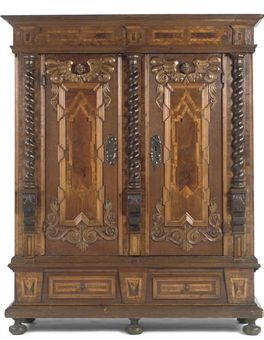One of the most common forms of case handmade furniture in the 17th century was the cupboard. At the beginning of the century, most cupboards had an open area above a closed lower section, but gradually, the form changed so that both sections were enclosed.
Generally the upper portion had two doors, while the base had doors or drawers below, depending on the use of the piece. By the end of the century, this style had evolved into the armoire, or wardrobe, which had two long doors from top to bottom.
Many armoires were influenced by architectural designs. They were quite often massive, highly decorated pieces with overhanging cornices. The carving gradually became less detailed, and by the end of the century, the principal decoration took the form of simple geometric patterns on the doors.
These armoires had a lower section containing drawers, and most of them had ball feet. The common terms for them were 'kas' (in the Low Countries), or 'schrank' (in Germany).
Two-part cupboards made in urban areas were less imposing. The cornice of the fitted furniture was smaller and decoration was provided by veneers of different coloured woods rather than carving.
Dutch or Flemish Cupboard
Made of oak, this cupboard is carved and embellished with architectural elements and caryatids. With its framed panels and ball feet, this cupboard retains many features of the Renaissance buffet a deux corps. Early 17th century.
Flemish Renaissance Oak Court Cupboard
Cupboards of this design, with small doors above an open area in the upper section, were made in great quantities in the 19th century, but 17th-century examples such as this one are quite scarce. This example includes six carved scenes of the life of Christ in full relief. Lower section opens to two small drawers side-by-side along the top and a shelf in the middle. Both top and lower doors have the original large inset iron locks. Provenance: "Oude Walle" castle, Lovendegem Belgium.
German Cupboard
The rectangular moulded top above a frieze inlaid with simulated panels, above a pair of doors, decorated with foliate carving and cherub's heads, flanked and divided by spirally turned pilasters, above a pair of dummy drawers, on bun feet.

No comments:
Post a Comment